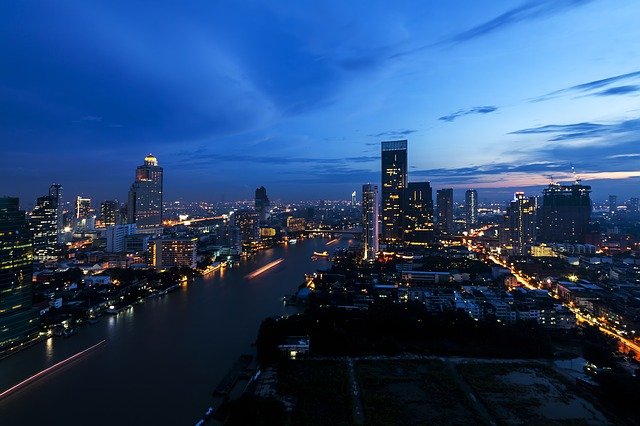By Tim Lambert
Early Thailand
The earliest inhabitants of what is now Thailand were hunter-gatherers. However, about 4,000 BC they began farming. They grew rice. At first, the farmers used stone tools but about 3,000 BC bronze was discovered. From about 500 BC the people of what is now Thailand used iron.
At first, what is now Thailand was divided into small states called Meuang. By 100 AD they were practicing Theravada Buddhism.
However, the ancestors of modern Thais are believed to have come from southern China. They migrated to Thailand between the 10th century and the 13th century AD.
Meanwhile, between the 9th century and the 13th century, much of what is now Thailand was ruled by the Khmers, a people from what is now Cambodia.
However, in the 13th century, several small states in Thailand in the Mekong River valley united to form a kingdom called Sukhothai. It is regarded as the first Thai kingdom. However, the first Thai kingdom did not last long. It declined in the late 14th century.
Meanwhile, during the 14th century, another kingdom arose in Thailand called Ayuthaya and it annexed the kingdom of Sukhothai. During the 15th century, Ayuthaya continued to grow.
The first Europeans to reach Thailand were the Portuguese in 1511. They were followed by the Dutch in 1605, the English in 1612, and the French in 1662.
In 1675 a Greek called Constantine Phaulkon became an official at the court in Thailand. He permitted the French to station soldiers in Thailand. However, he was removed from power in 1688 and the French were expelled. Afterward, Thailand adopted an isolationist policy. The Thais cut contact with Europe until the early 19th century.
In 1765 the Burmese invaded Ayuthaya and they captured the capital in 1767 and destroyed it. However, in 1769 a general named Phraya Taksin became king and he made a new capital at Thonburi across the river from Bangkok. He also built up an empire. He conquered much of Laos and other parts of Southeast Asia.
However, King Taksin began to have delusions and he was removed in a coup in 1782. A general named Chao Phraya Chakri replaced him as king. (He is known as Rama I). He had Taksin executed. He also made Bangkok the capital.
In 1809 Rama I was succeeded by his son Rama II (1809-1824). He was followed by Rama III (1824-1851). During their reigns, Thai culture flourished.
The next king Rama IV or Mongkut allowed the British to live in Thailand. He also allowed them to trade freely. He also signed treaties with many other Western countries and encouraged the study of Western science.
Rama V (1868-1901) abolished the custom that subjects must prostrate themselves in the king’s presence. He also abolished slavery and corvee (a tax paid in labor). Rama V also reformed Thailand’s government.
In the 19th century, Thailand avoided being colonized by Europeans. However, in 1893 Rama V was forced to cede Laos to France. He also ceded Cambodia to France in 1907 and in 1909 he was forced to cede territory in Malaya to Britain.
Modern Thailand
In July 1917 Thailand joined World War I on the allied side.
In November 1925 Prajadhipok became king of Thailand. However, on 24 June 1932, a revolution made Thailand a constitutional monarchy. In October 1933 Prince Boraradej led a counter-revolution but he was defeated. Prajadhipok abdicated in March 1935 in favor of his 10-year-old nephew Ananda Mahidol.
On 8 December 1941, Thailand agreed to let Japanese troops pass through the country to invade British Malaya. The Japanese then occupied Thailand and on 25 January 1942, Thailand declared war on Britain and the USA.
However, 90,000 Thai guerrillas led by Pridi Phanomyong fought the Japanese. In 1946 Thailand signed peace treaties with Britain and France. The same year Thailand joined the UN.
In May 1946 a new constitution for Thailand was published. However, on 9 June 1946 King Ananda Mahidol was shot in mysterious circumstances. King Bhumibol began his reign.
In 1947 Field-Marshal Phibul staged a coup. Although the king continued to reign Thailand then became a military dictatorship. Even after the death of Phibul in 1963, the army ruled Thailand.
However, in 1973 thousands of students demonstrated demanding a proper constitution for Thailand. The king prevented the army from crushing the demonstrators and Thailand returned to civilian government with a coalition of 17 parties.
However, in 1976 students demonstrated again. This time the police brutally suppressed the demonstrations, killing and injuring many students. The army then stepped in and installed a new government in Thailand.
From 1980 Thailand was led by General Prem Tinsulanonda who gradually introduced a more liberal regime. In 1988 he stepped down and Chatichai Choonhavan became prime minister. However, on 23 February 1991, the army staged a coup and General Suchinda took power.
Yet in an amazing display of ‘people power,’ Thais took to the streets in May 1992. Suchinda moved to repress the demonstrations but the king stopped him and eventually, Thailand returned to a civilian government. A new constitution was introduced in 1997. There was another military coup in Thailand in 2006 but in December 2007 democratic elections were held again.
In the late 20th century Thailand underwent amazing economic growth. It was transformed from a poor, agricultural country to a newly industrialized one. Thailand suffered from the economic crisis of 1997-98 but that proved to be a temporary setback.
In the early 21st century Thailand continued to grow economically. Like the rest of the world, Thailand suffered in the recession of 2009 but it soon recovered. Thailand also suffered severe floods in 2011 but again recovered. Thailand is now a prosperous country and its economy is growing steadily. Tourism is booming.
In 2025 Thailand became the first country in Southeast Asia to legalise same sex marriages.
In 2025 the population of Thailand was 71 million.

Bangkok
Last revised 2025